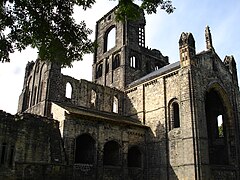| Kirkstall | |
|---|---|
 | |
Location within West Yorkshire | |
| Population | 20,673 [1] |
| Metropolitan borough | |
| Metropolitan county | |
| Region | |
| Country | England |
| Sovereign state | United Kingdom |
| Post town | LEEDS |
| Postcode district | LS3, LS4, LS5 |
| Dialling code | 0113 |
| Police | West Yorkshire |
| Fire | West Yorkshire |
| Ambulance | Yorkshire |
| UK Parliament | |
Kirkstall is a north-western suburb of Leeds, West Yorkshire, England, on the eastern side of the River Aire. The area sits in the Kirkstall ward of Leeds City Council and Leeds Central and Headingley parliamentary constituency, represented by Alex Sobel. The population of the ward at the 2011 Census was 21,709.[2]
To the west is Bramley, to the east is Headingley, and to the north are Hawksworth and West Park. Kirkstall is around 2 miles (3.2 km) from the city centre and is close to the University of Leeds and Leeds Metropolitan University. Its main visitor attraction is Kirkstall Abbey. Another landmark is St. Stephen's Church designed by the architect Robert Dennis Chantrell. Richard Oastler, a reformer and fighter for children's rights, is buried in a crypt under the church's east end.
In the 12th century Cistercian monks founded Kirkstall Abbey, a daughter house of Fountains Abbey in North Yorkshire. The Abbey House Museum opposite the abbey tells the story of the community and the town. Henry De Lacey, Baron of Pontefract, gave the land for the foundation of the abbey, and Kirkstall has a few roads named in his memory. The Abbey Light Railway, which connected the grounds of the abbey with the Bridge Road commercial area, was closed down in 2012.
- ^ http://statistics.leeds.gov.uk/PDF_Downloads/Files/NW%20Kirkstall.pdf[permanent dead link]
- ^ "Leeds City Ward population 2011". Neighbourhood Statistics. Office for National Statistics. Retrieved 26 February 2016.

